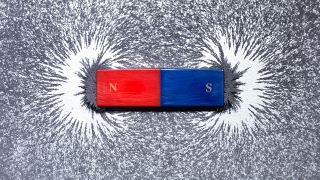The image of an atom, with electrons swarming around a central nucleus bulging with protons and neutrons, is as iconic in our perception of science as the DNA helix or the rings of Saturn. But however much we scratch the surface of these scientific fundamentals, we can go even deeper, focusing that microscope further and discovering even more forces that govern our world.
In his new book "CHARGE: Why Does Gravity Rule?", theoretical physicist Frank Close explores the fundamental forces that govern our world, posing questions along the way that seek to explain how the delicate balance of positive and negative charges paved the way for gravity to shape our universe.
In this except, he explains how magnetism, the most tangible fundamental forces, was discovered, where it comes from and how it got its name.
The force within
Magnetism is a manifestation of electricity, and vice versa. Electricity and magnetism were imprinted into our surroundings from the beginning. Five billion years ago when the new-born Earth was a hot plasma of swirling electrical currents, these flows created magnetic fields. As the magma cooled to form what is today the world's solid outer crust, magnetism was locked into minerals containing iron, such as magnetite.
Today, the Earth's liquid core is still a terpsichorean frenzy of electric currents, which generate a magnetic field. This extends into the atmosphere and far beyond, invisible to our normal senses. But in spreading from its source in the molten core to the heavens above, it first permeates the Earth's crust. This is where it leaves a tangible imprint, evidence that there exists a force more powerful than gravity at work within the Earth whose influence extends very far.
Way back in the earliest Precambrian, four billion years ago, as the surface cooled, atomic elements accumulated in the strata. The most stable of these, iron, is today one of the most abundant elements in the crust. Igneous rocks formed from volcanic lava. These rocks have the property that in the presence of a magnetic field, their atoms of iron act like soldiers on parade as they themselves become magnetic. This is exploited in popular demonstrations where the magnetic field of a bar magnet can be made visible.

Small filings of iron are first scattered on the surface of a table and then a magnet is placed carefully among them. Its magnetic field induces magnetism in the iron filings, turning them into thousands of miniature magnets. Each of these duly orients itself in the magnetic field, revealing how the direction of the magnetic force varies from place to place.
Related: Why do magnets have north and south poles?
The bar magnet is a simple model illustrating what happens for the magnetic Earth itself. Earth's north and south magnetic poles are analogous to those of the bar magnet, our planet's magnetic field extending far into space. There are no iron filings out in space, but there are large amounts of iron ores in the hills, cliffs, and mountains on Earth. In some places, by chance, these magnetic clusters are quite extensive, as on the Isle of Elba and Mount Ida in Asia Minor, where large outcrops retain the magnetic imprint in rocks known historically as lodestone, now named magnetite.
There are legends how thousands of years ago in ancient Greece, a shepherd wearing leather shoes held in place by iron nails stumbled — literally — across magnetite when the powerful magnetism gripped the nails in his footwear. Whether or not a shepherd named Magnes discovered the eponymous rock, and if so whether it was in Magnesia, north of Athens, or on Mount Ida in Asia Minor, or even another Mount Ida in Crete, it is very likely that such experiences, if less dramatic than in the story, would have happened on various occasions.
Certainly, the power of magnetism would have been apparent ever since the Iron Age. Lightning is a flash of electric current which generates intense magnetic fields and magnetizes ferrous rocks. Smelting to retrieve the pure iron metal from these sources would have revealed their magnetic attraction. So, the phenomenon has probably been known for some 3,000 years. Like the discovery of fire, that of magnetism probably arose in several places independently, all inspired by the natural magnetization of iron in rocks.
For magnetic rocks are ubiquitous. By the sixteenth century travellers recorded the best examples, from East India and the Chinese coast: "Very massive and weighty, [the stone] will draw or lift up the just weight of itself in iron or steel" [Robert Norman, The Newe Attractive, 1581]. As knowledge of the phenomenon spread from Greek myth to Latin, and on to English, the names morphed into 'Magnes rock' or 'magnet'.
© [Oxford University Press]
Extract from CHARGE: Why Does Gravity Rule? by Frank Close, published by Oxford University Press, available in hardback and eBook formats
https://ift.tt/ETkXd0u
Science

No comments:
Post a Comment